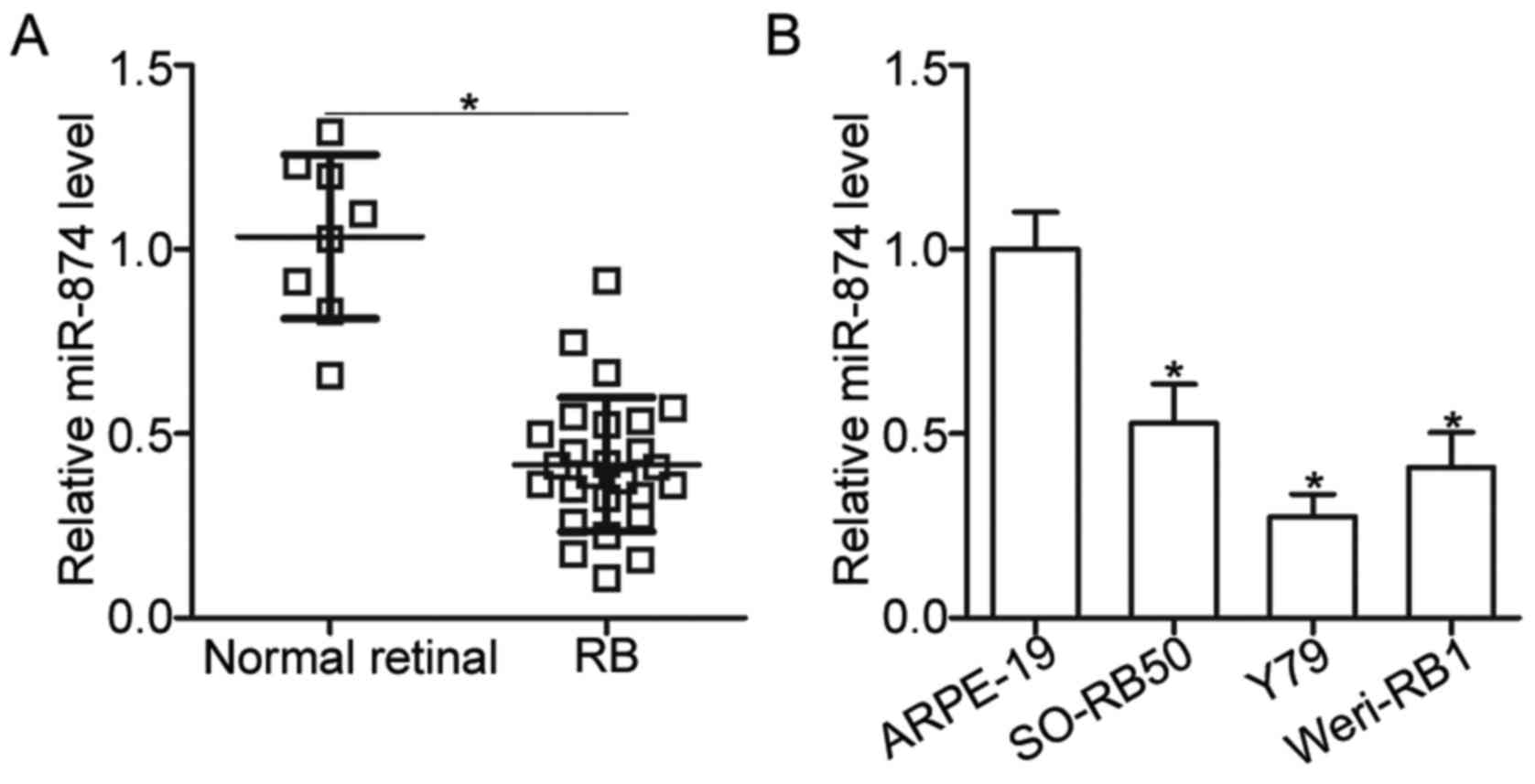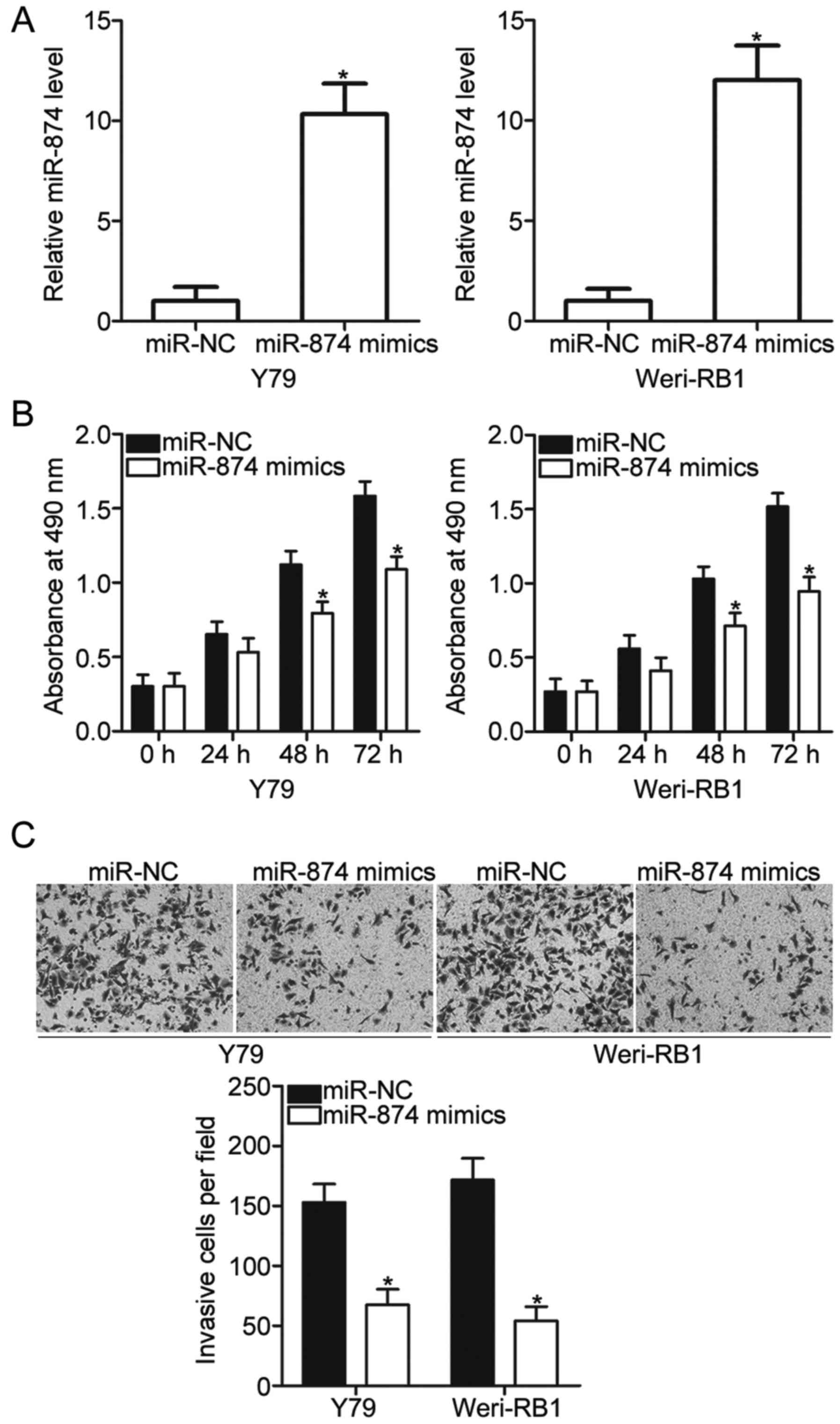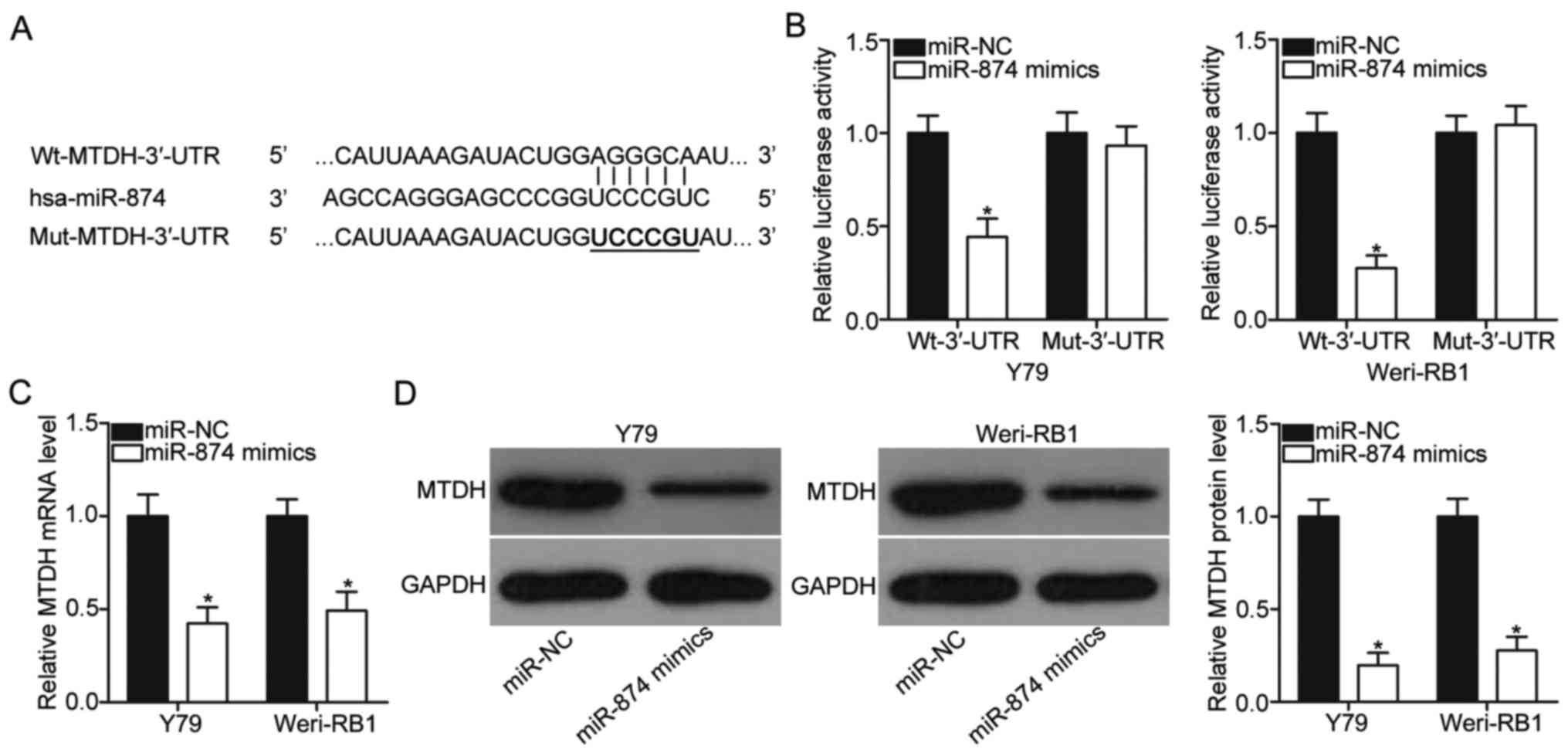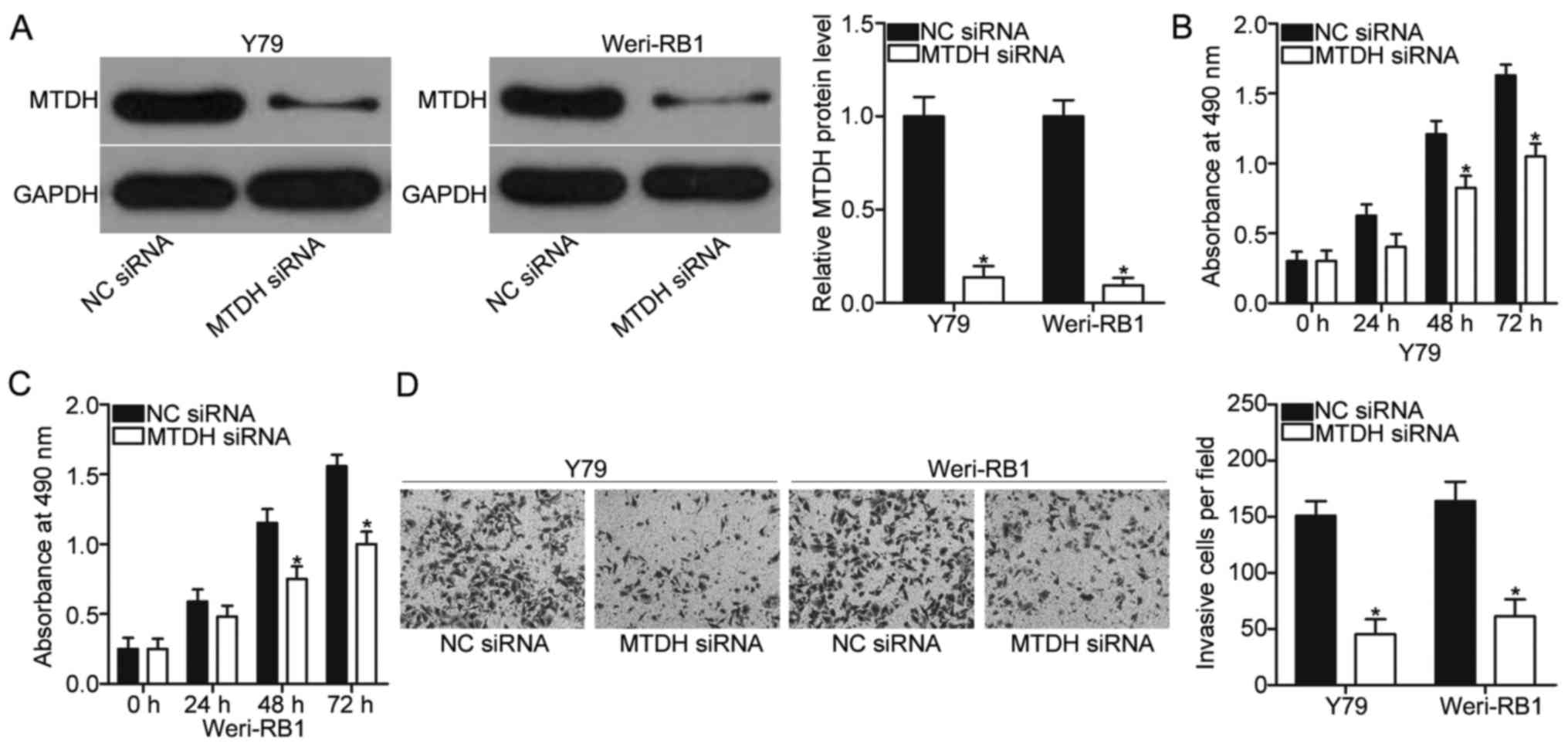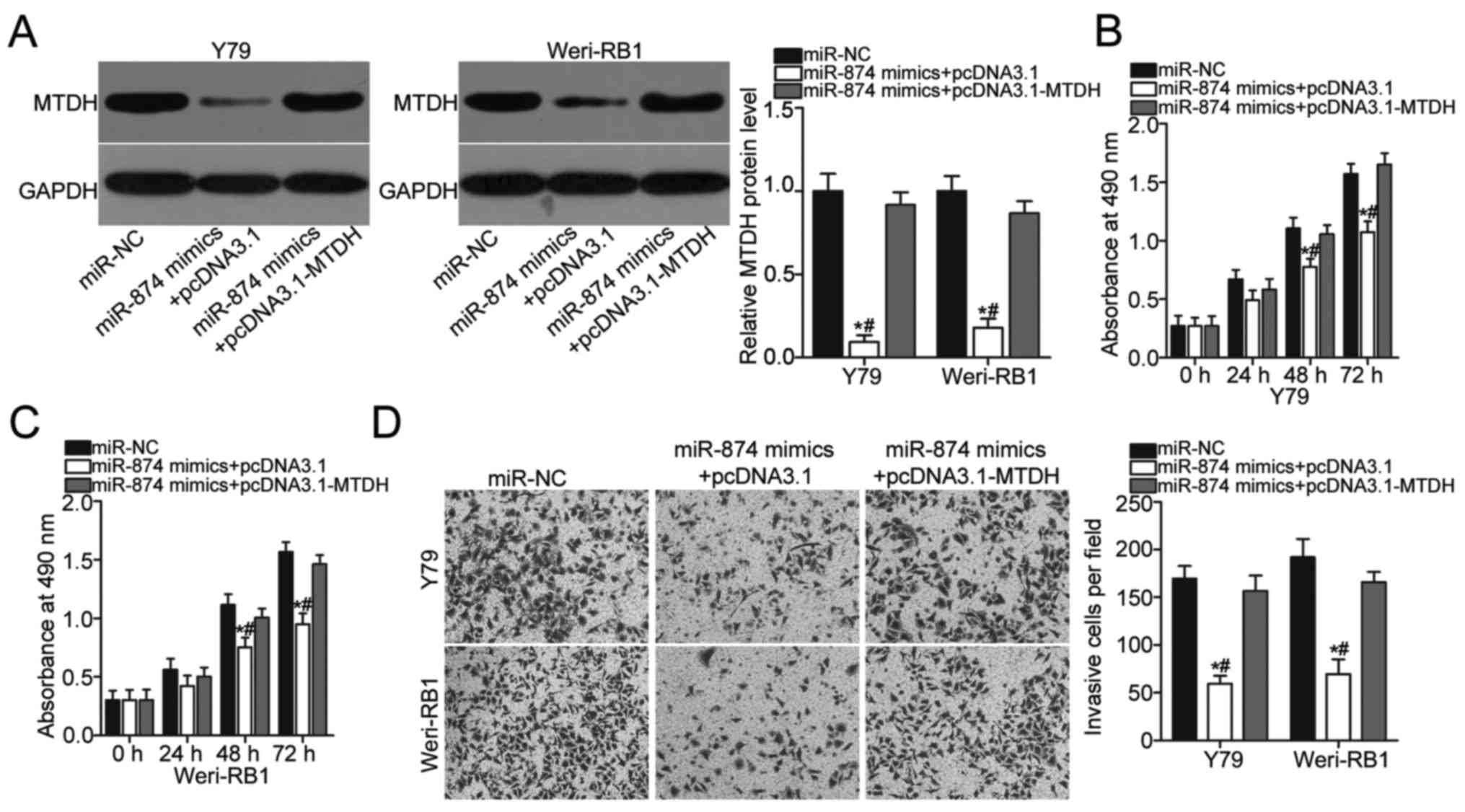MicroRNA‑874 prohibits the proliferation and invasion of retinoblastoma cells by directly targeting metadherin
Retraction in: /10.3892/mmr.2022.12900
- Authors:
- Published online on: July 16, 2018 https://doi.org/10.3892/mmr.2018.9295
- Pages: 3099-3105
Abstract
Introduction
Retinoblastoma (RB) is a rare human malignancy and usually occurs in infants and children (1). The incidence of RB is approximately 1/15,000–1/20,000 live births, translating to about 9,000 novel cases annually worldwide (2). Currently, the primary treatments for patients with RB include surgical resection, chemoradiotherapy, thermotherapy and cryotherapy (3). Despite remarkable improvements in RB diagnosis and therapy, the overall prognosis for patients with this disease remains poor, primarily due to diagnosis and treatment delay, metastasis to distant organs and chemoresistance (4–6). Highly expressed oncogenes, underexpressed tumour suppressor genes and epigenetic changes in oncogenic methylation are determining factors that initiate and drive the formation and progression of RB; however, detailed mechanisms of RB pathogenesis remain largely unknown (7). Therefore, great efforts are required to determine the underlying mechanisms of RB and identify new treatment strategies for the therapy of patients with this fatal malignant tumour.
MicroRNAs (miRNAs/miRs) are a class of highly conserved, single-stranded and non-coding short RNA molecules with an average length of 19–23 nucleotides (8). miRNAs negatively regulate gene expression, mainly by directly binding to conserved sites in the 3′-untranslated regions (3′-UTRs) of their target genes, thereby inducing transcriptional repression or mRNA degradation (9). Over half of miRNAs are located at cancer-related genomic regions or fragile sites, indicating that miRNAs may be closely related to cancer initiation and progression (10). Numerous miRNAs are deregulated in RB, such as miR-138 (11), miR-448 (12), miR-498 (13) and miR-613 (14). miRNAs deregulation plays critical roles in RB oncogenesis and development by regulating cell proliferation, apoptosis, cycle, metastasis and invasion (15,16). miRNAs may serve oncogenic or tumour suppressive roles, in which oncogenic miRNAs are overexpressed and tumour suppressor miRNAs are weakly expressed in cancers (17). Considering the regulatory roles of miRNAs in RB, miRNAs may be investigated as promising therapeutic targets for the management of patients with RB.
miR-874-3p (miR-874) has been recently reported to be downregulated in several types of human cancer and play an essential role in cancer progression (18–20). However, the expression pattern and detailed roles of miR-874 in RB, as well as the underlying molecular mechanisms in RB, have not been clearly elucidated. Therefore, this study detected miR-874 expression in both RB tissues and cell lines. We also determined the biological roles of miR-874 in RB and examined the underlying mechanisms of its actions in RB cells.
Materials and methods
Tissue samples
A total of 26 RB tissues were collected from patients with RB who underwent surgery in Affiliated Hospital of Weifang Medical University (Weifang, China). In total, 8 normal retinal tissues were obtained from patients suffering from globe rupture. These subjects did not receive thermotherapy, radiotherapy or chemotherapy treatment before surgery. Tissues were quickly snap-frozen in liquid nitrogen and stored in a −80°C freezer until further RNA extraction. This study was approved by the Ethics Committee of the Affiliated Hospital of Weifang Medical University. Written informed consent was also obtained from each of the patients enrolled.
Cell culture
One normal retinal pigmented epithelial cell line ARPE-19 and three RB cell lines (SO-RB50, Y79, and Weri-RB1) were purchased from American Type Culture Collection (Manassas, VA, USA). All these cell lines were grown at 37°C under a humidified atmosphere containing 5% CO2, and cultured in Dulbecco's modified Eagle's medium (DMEM) containing 10% fetal bovine serum (FBS), 100 U/ml penicillin and 100 µg/ml streptomycin (all from Gibco; Thermo Fisher Scientific, Inc., Waltham, MA, USA).
Transfection
miR-874 mimics, negative control miRNA mimics (miR-NC), MTDH siRNA and negative control siRNA (NC siRNA) were synthesized and obtained from GenePharma Co., Ltd. (Shanghai, China). MTDH overexpression vector pcDNA3.1-MTDH and empty pcDNA3.1 vector was ordered from Chinese Academy of Sciences (Changchun, China). For transfection, cells were seeded into 6-well plates at 60–70% confluence, and then transfected with mimics, siRNA or vector using Lipofectamine® 2000 (Invitrogen; Thermo Fisher Scientific, Inc.) in accordance with the manufacturer's instructions. Reverse transcription-quantitative polymerase chain reaction (RT-qPCR) and western blot analysis were applied to determine transfection efficiency.
RT-qPCR
Total RNA of tissues or cells was isolated using TRIzol reagent (Invitrogen; Thermo Fisher Scientific, Inc.), and the concentration of total RNA was detected with a NanoDrop 2000/2000c spectrophotometer (NanoDrop Technologies; Thermo Fisher Scientific, Inc., Wilmington, DE, USA). To detect miR-874 expression, total RNA was reverse transcribed into complementary DNA (cDNA) using a TaqMan® MicroRNA Reverse Transcription kit (Applied Biosystems; Thermo Fisher Scientific, Inc.). Subsequently, cDNA was amplified by qPCR using a TaqMan MicroRNA Assay kit (Applied Biosystems; Thermo Fisher Scientific, Inc.). To analyse MTDH mRNA expression, reverse transcription was conducted using M-MLV reverse transcriptase (Thermo Fisher Scientific, Inc.), followed by qPCR with Power SYBR-Green PCR Master Mix (Thermo Fisher Scientific, Inc., Waltham, MA, USA). U6 and GAPDH served as internal controls for the determination of miR-874 and MTDH mRNA expression, respectively. The 2−ΔΔCq method was used to analyse gene expression (21).
MTT assay
After transfection for 24 h, the cells were collected and seeded into 96-well plates at a density of 3,000 cells/well. The cells were then incubated at 37°C under a humidified atmosphere containing 5% CO2 for 0, 24, 48 and 72 h. At every time point, MTT assay was performed to detect cell proliferation. A total of 20 µl MTT (5 mg/ml; Sigma-Aldrich; Merck KGaA, Darmstadt, Germany) was added into each well and incubated at 37°C with 5% CO2 for 4 h. The culture medium was discarded, and 100 µl of DMSO (Sigma-Aldrich; Merck KGaA) was added into each well to dissolve formazan crystals. Absorbance was read at a wavelength of 490 nm using a microplate reader (Bio-Rad Laboratories, Inc., Hercules, CA, USA).
Transwell invasion assay
Following transfection for 48 h, 1×105 transfected cells in FBS-free DMEM were plated into the upper compartment of 24-well Transwell chambers (8 µm pore size; Corning Incorporated, Corning, NY, USA) that were precoated with Matrigel matrix gel (BD Biosciences, Franklin Lakes, NJ, USA). The lower compartment of Transwell chambers was filled with 600 µl of DMEM supplemented with 20% FBS. Approximately 24 h later, non-invasive cells on the upper surface of the membrane were gently removed using a cotton swab. The invasive cells were fixed with 4% paraformaldehyde and stained with 0.1% crystal violet. The number of invasive cells was counted under a Leica inverted microscope (×200 magnification; Leica Microsystems GmbH, Wetzlar, Germany) in at least 5 randomly selected visual fields.
Bioinformatics analysis
The putative targets of miR-874 were predicted using public key algorithms, including TargetScan (www.targetscan.org) and miRanda (www.microrna.org).
Luciferase reporter assay
The wild-type (Wt) and mutant 3′-UTR of MTDH segment was amplified by GenePharma Co., Ltd., and was inserted into the pmirGLO luciferase reporter vector (Promega Corporation, Madison, WI, USA). For reporter assay, cells were seeded into 24-well plates, and cotransfected with miR-874 mimics or miR-NC and pmirGLO-Wt-MTDH-3′-UTR or pmirGLO-Mut-MTDH-3′-UTR using Lipofectamine® 2000. Transfected cells were harvested 48 h post-transfection, and were subjected to the detection of luciferase activities using a Dual-Luciferase Reporter assay system (Promega Corporation) following the manufacturer's instructions. Firefly luciferase activity was normalized to that of Renilla luciferase activity.
Western blot analysis
Total protein of tissues or cells was extracted using a Total Protein Extraction kit (KeyGen Biotech Co., Ltd., Nanjing, China), and the protein concentration was evaluated using a BCA assay kit (Thermo Fisher Scientific, Inc.). Equal amount of total protein per lane was separated using 10% sodium dodecyl sulfate polyacrylamide gel electrophoresis and transferred to polyvinylidene fluoride membranes (EMD Millipore, Billerica, MA, USA). Subsequently, the membranes were blocked with 5% dried skimmed milk dissolved in TBS containing 0.1% Tween-20 (TBST) at room temperature for 2 h followed by incubation overnight at 4°C with primary antibodies. After washing three times with TBST, the membranes were incubated at room temperature for 2 h with horseradish peroxidase-conjuncted goat anti-mouse secondary antibody (1:5,000 dilution; cat. no. sc-516102; Santa Cruz Biotechnology, Inc., Dallas, TX, USA). The protein bands were visualized with an enhanced chemiluminescence detection system (Pierce; Thermo Fisher Scientific, Inc.). The primary antibodies used in this study included mouse anti-human MTDH monoclonal antibody (1:1,000 dilution; cat. no. sc-517220; Santa Cruz Biotechnology, Inc.) and mouse anti-human GAPDH monoclonal antibody (1:1,000 dilution; cat. no. sc-51907; Santa Cruz Biotechnology, Inc.). GAPDH was used as the internal control.
Statistical analysis
All data were presented as the mean ± standard deviation. All statistical analyses were conducted using SPSS software (version 18.0; SPSS, Inc., Chicago, IL, USA). Student's t-test was adopted for comparisons between two groups, whereas one-way ANOVA was used for comparisons between multiple groups. Student-Newman-Keuls test was used as a post hoc test following ANOVA. P<0.05 was considered to indicate a statistically significant difference.
Results
Expression of miR-874 is decreased in RB tissues and cell lines
To examine the expression pattern of miR-874 in RB, we detected miR-874 expression in 26 RB tissues and 8 normal retinal tissues. The results of RT-qPCR analysis showed that miR-874 expression was significantly downregulated in RB tissues compared with that in normal retinal tissues (P<0.05; Fig. 1A). To confirm this observation, we determined the expression level of miR-874 in the normal retinal pigmented epithelial cell line ARPE-19 and three RB cell lines SO-RB50, Y79 and Weri-RB1. As expected, miR-874 was lower in the three RB cell lines than in ARPE-19 (P<0.05; Fig. 1B). These results suggested that miR-874 may play important roles in RB development.
miR-874 restoration inhibits RB cell proliferation and invasion
Considering that miR-874 is weakly expressed in RB, we hypothesised that miR-874 may play tumour-suppressive roles in RB. To confirm this hypothesis, we selected Y79 and Weri-RB1 cell lines, which exhibit relatively lower endogenous miR-874 expression among the three RB cell lines, for subsequent experiments. Y79 and Weri-RB1 cells were transfected with miR-874 mimics or miR-NC, and the expression level of miR-874 was detected by RT-qPCR. As shown in Fig. 2A, miR-874 expression was evidently upregulated in Y79 and Weri-RB1 cells after transfection with miR-874 mimics (P<0.05). MTT assay revealed that ectopic miR-874 expression inhibited Y79 and Weri-RB1 cell proliferation compared with that in miR-NC groups (P<0.05; Fig. 2B). Transwell invasion assay was utilised to examine the effect of miR-874 on RB cell invasion. miR-874 overexpression reduced the invasive abilities of Y79 and Weri-RB1 cells compared with those in miR-NC groups (P<0.05; Fig. 2C). In summary, these results suggested that miR-874 may serve as a tumour suppressor in RB.
miR-874 directly targets and regulates MTDH expression in RB cells
To understand the mechanisms underlying the action of miR-874 in RB, bioinformatics analysis was performed to predict the putative targets of miR-874. We focused on MTDH because of its crucial roles in regulating RB malignancy (22) (Fig. 3A). Luciferase reporter assay was performed to evaluate whether miR-874 can directly recognise and bind to the 3′-UTR of MTDH. The upregulation of miR-874 significantly suppressed the luciferase activities in Y79 and Weri-RB1 cells that were transfected with plasmid containing the wild type 3′-UTR of MTDH (P<0.05) but not in cells transfected with plasmid harbouring the mutated 3′-UTR (Fig. 3B). To further investigate the relationship between miR-874 and MTDH, we conducted RT-qPCR and Western blot analysis to analyse the MTDH mRNA and protein levels in Y79 and Weri-RB1 cells after transfection with miR-874 mimics or miR-NC. The mRNA (P<0.05; Fig. 3C) and protein (P<0.05; Fig. 3D) levels of MTDH were significantly reduced by miR-874 overexpression in Y79 and Weri-RB1 cells. These results suggested that MTDH may be a direct target gene of miR-874 in RB cells.
MTDH knockdown imitates the inhibitory roles of miR-874 on RB cells
Given that MTDH was validated as a direct target gene of miR-874, we hypothesised that MTDH inhibition can imitate the suppressive roles of miR-874 in RB cells. To confirm this hypothesis, we employed MTDH siRNA to knock down MTDH expression in Y79 and Weri-RB1 cells. After transfection, Western blot analysis indicated that MTDH expression was efficiently knocked down in both Y79 and Weri-RB1 cells (P<0.05; Fig. 4A). MTT and Transwell invasion assays revealed that MTDH inhibition attenuated the proliferation (P<0.05; Fig. 4B and C) and invasion (P<0.05; Fig. 4D) of Y79 and Weri-RB1 cells, which was similar to the effects caused by miR-874 overexpression. These results suggested that MTDH is a functional target of miR-874 in RB cells.
Forced MTDH expression partially reverses the suppressive effects of miR-874 on proliferation and invasion of RB cells
To elucidate whether the action of miR-874 on RB cells is mediated by MTDH, rescue experiments were performed in Y79 and Weri-RB1 cells that were co-transfected with miR-874 mimics and pcDNA3.1 or pcDNA3.1-MTDH lacking the respective 3′-UTR. MTDH downregulation in Y79 and Weri-RB1 cells caused by miR-874 overexpression was rescued by co-transfection with pcDNA3.1-MTDH (P<0.05; Fig. 5A). Furthermore, restored MTDH expression abolished the inhibitory effects of exogenous miR-874 on the proliferation (P<0.05; Fig. 5B and C) and invasion (P<0.05; Fig. 5D) of Y79 and Weri-RB1 cells. Overall, these results clearly demonstrated that the tumour-suppressive roles of miR-874 on RB cells were partly mediated by MTDH downregulation.
Discussion
miRNAs play important roles in regulating gene expression by directly binding to the 3′-UTR of target genes (9). Multiple miRNAs are dysregulated in RB, and their dysregulation is closely related to RB malignancy (15). Therefore, exploring the detailed roles of miRNAs in RB is valuable to further understand the mechanisms underlying RB formation and progression, which may facilitate the development of effective therapeutic targets for patients with this disease. In this research, we analysed miR-874 expression in both RB tissues and cell lines. The data of RT-qPCR analysis indicated that miR-874 expression was significantly downregulated in RB tissues and cell lines. Thus, miR-874 may serve tumour-suppressive roles in RB. Subsequent functional experiments demonstrated that miR-874 upregulation attenuated cell proliferation and invasion in RB. Furthermore, MTDH was identified as a direct target gene of miR-874 in RB. These results suggested that miR-874 may be a potential diagnostic and therapeutic target for the therapy of patients with RB.
miR-874 expression is aberrantly expressed in several human cancers. For example, its expression is reduced in hepatocellular carcinoma. Reduced miR-874 expression is correlated with tumour size, vascular invasion, lymph node metastasis, tumour node metastasis (TNM) stage, clinical stage and tumour differentiation (23,24). miR-874 expression is also downregulated in osteosarcoma tissues and cell lines (25,26). Low miR-874 expression is strongly related to TNM stage, tumour size and lymph node metastasis in patients with osteosarcoma (26). Weakly expressed miR-874 expression also has been reported in breast cancer (18), gastric cancer (19), head and neck squamous cell carcinoma (20), lung cancer (27) and colorectal cancer (28). These findings suggest that miR-874 can be developed as a novel biomarker for the diagnosis and prediction of the prognosis of patients with these specific cancer types.
miR-874 serves important roles in the oncogenesis and progression of multiple human cancer types. For example, resuming miR-874 expression inhibits hepatocellular carcinoma cell growth, metastasis and epithelial-mesenchymal transition in vitro and reduces tumourigenicity in vivo (23,24,29). In osteosarcoma, miR-874 upregulation represses cell proliferation, migration and invasion, promotes cell apoptosis in vitro and inhibits tumour growth in vivo (25,26). In breast cancer, ectopic miR-874 expression restricts cell proliferation, increases apoptosis and induces cell cycle arrest (30). In head and neck squamous cell carcinoma, forced miR-874 expression suppresses cell proliferation and invasion and promotes cell apoptosis via G2/M arrest induction (20,31). These findings indicate that miR-874 restoration inhibits the progression of these human cancers, suggesting that this miRNA may be a promising therapeutic target.
In the current study, we demonstrated for the first time that MTDH is a direct and functional target of miR-874 in RB cells. MTDH, also known as astrocyte-elevated gene-1, is located on chromosome 8q22 and is overexpressed in a variety of human malignant tumours, such as thyroid (32), breast (33), gastric (34), colorectal (35), and cervical (36) cancers. MTDH expression is also upregulated in RB tissues and cell lines and is linked with the tumor stage of RB patients (22). Inhibition of MTDH significantly inhibits cell proliferation and promotes apoptosis in RB (22). MTDH can be directly targeted by multiple miRNAs, such as miR-136 (37) in osteosarcoma, miR-216b (38) in glioma and miR-1271 (39) in colorectal cancer. These findings suggest that miRNA-based targeted therapy against MTDH expression may be a potential strategy for anticancer therapy.
In conclusion, miR-874 was underexpressed in RB tissues and cell lines. miR-874 overexpression inhibited cell proliferation and invasion in RB by directly targeting MTDH. Understanding the molecular mechanisms underlying the action of miR-874 in RB may provide novel insights into RB development and provide effective therapeutic target for patients with this malignancy. However, this study suffered from several limitations that must be recognised. The present work demonstrated that MTDH was a direct target of miR-874 in RB but could not conclude that MTDH was the primary or only target. Furthermore, this research did not explore the effects of miR-874 on the malignant behaviour of RB cells in vivo. In the future, intensive studies are necessary to overcome these limitations.
Acknowledgements
Not applicable.
Funding
No funding was received.
Availability of data and materials
The datasets used and/or analyzed during the present study are available from the corresponding author on reasonable request.
Authors' contributions
XW designed the research. YfZ, XW, and YhZ performed functional experiments. All authors read and approved the final draft.
Ethics approval and consent to participate
The present study was approved by the Ethics Committee of Affiliated Hospital of Weifang Medical University (Weifang, China), and was performed in accordance with the Declaration of Helsinki and the guidelines of the Ethics Committee of Affiliated Hospital of Weifang Medical University. Written informed consent was obtained from all patients for the use of their clinical tissues.
Patient consent for publication
Not applicable.
Competing interests
The authors declare that they have no competing interests.
References
|
Broaddus E, Topham A and Singh AD: Incidence of retinoblastoma in the USA: 1975–2004. Br J Ophthalmol. 93:21–23. 2009. View Article : Google Scholar : PubMed/NCBI | |
|
Kivelä T: The epidemiological challenge of the most frequent eye cancer: Retinoblastoma, an issue of birth and death. Br J Ophthalmol. 93:1129–1131. 2009. View Article : Google Scholar : PubMed/NCBI | |
|
Friedman DL, Himelstein B, Shields CL, Shields JA, Needle M, Miller D, Bunin GR and Meadows AT: Chemoreduction and local ophthalmic therapy for intraocular retinoblastoma. J Clin Oncol. 18:12–17. 2000. View Article : Google Scholar : PubMed/NCBI | |
|
Jabbour P, Chalouhi N, Tjoumakaris S, Gonzalez LF, Dumont AS, Chitale R, Rosenwasser R, Bianciotto CG and Shields C: Pearls and pitfalls of intraarterial chemotherapy for retinoblastoma. J Neurosurg Pediatr. 10:175–181. 2012. View Article : Google Scholar : PubMed/NCBI | |
|
Kaliki S, Shields CL, Rojanaporn D, Al-Dahmash S, McLaughlin JP, Shields JA and Eagle RC Jr: High-risk retinoblastoma based on international classification of retinoblastoma: Analysis of 519 enucleated eyes. Ophthalmology. 120:997–1003. 2013. View Article : Google Scholar : PubMed/NCBI | |
|
Canturk S, Qaddoumi I, Khetan V, Ma Z, Furmanchuk A, Antoneli CB, Sultan I, Kebudi R, Sharma T, Rodriguez-Galindo C, et al: Survival of retinoblastoma in less-developed countries impact of socioeconomic and health-related indicators. Br J Ophthalmol. 94:1432–1436. 2010. View Article : Google Scholar : PubMed/NCBI | |
|
Benavente CA and Dyer MA: Genetics and epigenetics of human retinoblastoma. Annu Rev Pathol. 10:547–562. 2015. View Article : Google Scholar : PubMed/NCBI | |
|
Lee RC, Feinbaum RL and Ambros V: The C. elegans heterochronic gene lin-4 encodes small RNAs with antisense complementarity to lin-14. Cell. 75:843–854. 1993. View Article : Google Scholar : PubMed/NCBI | |
|
Brennecke J, Stark A, Russell RB and Cohen SM: Principles of microRNA-target recognition. PLoS Biol. 3:e852005. View Article : Google Scholar : PubMed/NCBI | |
|
Calin GA, Sevignani C, Dumitru CD, Hyslop T, Noch E, Yendamuri S, Shimizu M, Rattan S, Bullrich F, Negrini M and Croce CM: Human microRNA genes are frequently located at fragile sites and genomic regions involved in cancers. Proc Natl Acad Sci USA. 101:2999–3004. 2004. View Article : Google Scholar : PubMed/NCBI | |
|
Wang Z, Yao YJ, Zheng F, Guan Z, Zhang L, Dong N and Qin WJ: Mir-138-5p acts as a tumor suppressor by targeting pyruvate dehydrogenase kinase 1 in human retinoblastoma. Eur Rev Med Pharmacol Sci. 21:5624–5629. 2017.PubMed/NCBI | |
|
Wu S, Ai N, Liu Q and Zhang J: MicroRNA-448 inhibits the progression of retinoblastoma by directly targeting ROCK1 and regulating PI3K/AKT signalling pathway. Oncol Rep. 39:2402–2412. 2018.PubMed/NCBI | |
|
Yang L, Wei N, Wang L, Wang X and Liu QH: miR-498 promotes cell proliferation and inhibits cell apoptosis in retinoblastoma by directly targeting CCPG1. Childs Nerv Syst. 34:417–422. 2018. View Article : Google Scholar : PubMed/NCBI | |
|
Zhang Y, Zhu X, Zhu X, Wu Y, Liu Y, Yao B and Huang Z: miR-613 suppresses retinoblastoma cell proliferation, invasion, and tumor formation by targeting E2F5. Tumour Biol. 39:10104283176916742017.PubMed/NCBI | |
|
Golabchi K, Soleimani-Jelodar R, Aghadoost N, Momeni F, Moridikia A, Nahand JS, Masoudifar A, Razmjoo H and Mirzaei H: MicroRNAs in retinoblastoma: Potential diagnostic and therapeutic biomarkers. J Cell Physiol. 233:3016–3023. 2018. View Article : Google Scholar : PubMed/NCBI | |
|
Mirakholi M, Mahmoudi T and Heidari M: MicroRNAs horizon in retinoblastoma. Acta Med Iran. 51:823–829. 2013.PubMed/NCBI | |
|
Shenouda SK and Alahari SK: MicroRNA function in cancer: Oncogene or a tumor suppressor? Cancer Metastasis Rev. 28:369–378. 2009. View Article : Google Scholar : PubMed/NCBI | |
|
Zhang L, Yan DL, Yang F, Wang DD, Chen X, Wu JZ, Tang JH and Xia WJ: DNA methylation mediated silencing of microRNA-874 is a promising diagnosis and prognostic marker in breast cancer. Oncotarget. 8:45496–45505. 2017.PubMed/NCBI | |
|
Zhang X, Tang J, Zhi X, Xie K, Wang W, Li Z, Zhu Y, Yang L, Xu H and Xu Z: miR-874 functions as a tumor suppressor by inhibiting angiogenesis through STAT3/VEGF-A pathway in gastric cancer. Oncotarget. 6:1605–1617. 2015.PubMed/NCBI | |
|
Nohata N, Hanazawa T, Kinoshita T, Inamine A, Kikkawa N, Itesako T, Yoshino H, Enokida H, Nakagawa M, Okamoto Y and Seki N: Tumour-suppressive microRNA-874 contributes to cell proliferation through targeting of histone deacetylase 1 in head and neck squamous cell carcinoma. Br J Cancer. 108:1648–1658. 2013. View Article : Google Scholar : PubMed/NCBI | |
|
Livak KJ and Schmittgen TD: Analysis of relative gene expression data using real-time quantitative PCR and the 2(-Delta Delta C(T)) method. Methods. 25:402–408. 2001. View Article : Google Scholar : PubMed/NCBI | |
|
Chang Y, Li B, Xu X, Shen L, Bai H, Gao F, Zhang Z and Jonas JB: Lentivirus-mediated knockdown of astrocyte elevated gene-1 inhibits growth and induces apoptosis through MAPK pathways in human retinoblastoma cells. PLoS One. 11:e01487632016. View Article : Google Scholar : PubMed/NCBI | |
|
Zhang Y, Wei Y, Li X, Liang X, Wang L, Song J, Zhang X, Zhang C, Niu J, Zhang P, et al: microRNA-874 suppresses tumor proliferation and metastasis in hepatocellular carcinoma by targeting the DOR/EGFR/ERK pathway. Cell Death Dis. 9:1302018. View Article : Google Scholar : PubMed/NCBI | |
|
Jiang T, Guan LY, Ye YS, Liu HY and Li R: miR-874 inhibits metastasis and epithelial-mesenchymal transition in hepatocellular carcinoma by targeting SOX12. Am J Cancer Res. 7:1310–1321. 2017.PubMed/NCBI | |
|
Ghosh T, Varshney A, Kumar P, Kaur M, Kumar V, Shekhar R, Devi R, Priyanka P, Khan MM and Saxena S: MicroRNA-874-mediated inhibition of the major G1/S phase cyclin, CCNE1, is lost in osteosarcomas. J Biol Chem. 292:21264–21281. 2017. View Article : Google Scholar : PubMed/NCBI | |
|
Dong D, Gong Y, Zhang D, Bao H and Gu G: miR-874 suppresses the proliferation and metastasis of osteosarcoma by targeting E2F3. Tumour Biol. 37:6447–6455. 2016. View Article : Google Scholar : PubMed/NCBI | |
|
Kesanakurti D, Maddirela DR, Chittivelu S, Rao JS and Chetty C: Suppression of tumor cell invasiveness and in vivo tumor growth by microRNA-874 in non-small cell lung cancer. Biochem Biophys Res Commun. 434:627–633. 2013. View Article : Google Scholar : PubMed/NCBI | |
|
Zhao B and Dong AS: miR-874 inhibits cell growth and induces apoptosis by targeting STAT3 in human colorectal cancer cells. Eur Rev Med Pharmacol Sci. 20:269–277. 2016.PubMed/NCBI | |
|
Leong KW, Cheng CW, Wong CM, Ng IO, Kwong YL and Tse E: miR-874-3p is down-regulated in hepatocellular carcinoma and negatively regulates PIN1 expression. Oncotarget. 8:11343–11355. 2017. View Article : Google Scholar : PubMed/NCBI | |
|
Wang L, Gao W, Hu F, Xu Z and Wang F: MicroRNA-874 inhibits cell proliferation and induces apoptosis in human breast cancer by targeting CDK9. FEBS Lett. 588:4527–4535. 2014. View Article : Google Scholar : PubMed/NCBI | |
|
Nohata N, Hanazawa T, Kikkawa N, Sakurai D, Fujimura L, Chiyomaru T, Kawakami K, Yoshino H, Enokida H, Nakagawa M, et al: Tumour suppressive microRNA-874 regulates novel cancer networks in maxillary sinus squamous cell carcinoma. Br J Cancer. 105:833–841. 2011. View Article : Google Scholar : PubMed/NCBI | |
|
Li WF, Wang G, Zhao ZB and Liu CA: High expression of metadherin correlates with malignant pathological features and poor prognostic significance in papillary thyroid carcinoma. Clin Endocrinol (Oxf). 83:572–580. 2015. View Article : Google Scholar : PubMed/NCBI | |
|
Li J, Zhang N, Song LB, Liao WT, Jiang LL, Gong LY, Wu J, Yuan J, Zhang HZ, Zeng MS and Li M: Astrocyte elevated gene-1 is a novel prognostic marker for breast cancer progression and overall patient survival. Clin Cancer Res. 14:3319–3326. 2008. View Article : Google Scholar : PubMed/NCBI | |
|
Dong L, Qin S, Li Y, Zhao L, Dong S, Wang Y, Zhang C and Han S: High expression of astrocyte elevated gene-1 is associated with clinical staging, metastasis, and unfavorable prognosis in gastric carcinoma. Tumour Biol. 36:2169–2178. 2015. View Article : Google Scholar : PubMed/NCBI | |
|
Gnosa S, Shen YM, Wang CJ, Zhang H, Stratmann J, Arbman G and Sun XF: Expression of AEG-1 mRNA and protein in colorectal cancer patients and colon cancer cell lines. J Transl Med. 10:1092012. View Article : Google Scholar : PubMed/NCBI | |
|
Yu JQ, Zhou Q, Zhu H, Zheng FY and Chen ZW: Overexpression of astrocyte elevated gene-1 (AEG-1) in cervical cancer and its correlation with angiogenesis. Asian Pac J Cancer Prev. 16:2277–2281. 2015. View Article : Google Scholar : PubMed/NCBI | |
|
Guo T and Pan G: MicroRNA-136 functions as a tumor suppressor in osteosarcoma via regulating metadherin. Cancer Biomark. 22:79–87. 2018. View Article : Google Scholar : PubMed/NCBI | |
|
Chen Z, Wu Y, Song S, Zhu X and Zhu J: MicroRNA-216b inhibits cell proliferation and invasion in glioma by directly targeting metadherin. Mol Med Rep. 16:9749–9757. 2017. View Article : Google Scholar : PubMed/NCBI | |
|
Sun X, Zhai H, Chen X, Kong R and Zhang X: MicroRNA-1271 suppresses the proliferation and invasion of colorectal cancer cells by regulating metadherin/Wnt signaling. J Biochem Mol Toxicol. 32:e220282018. View Article : Google Scholar |



